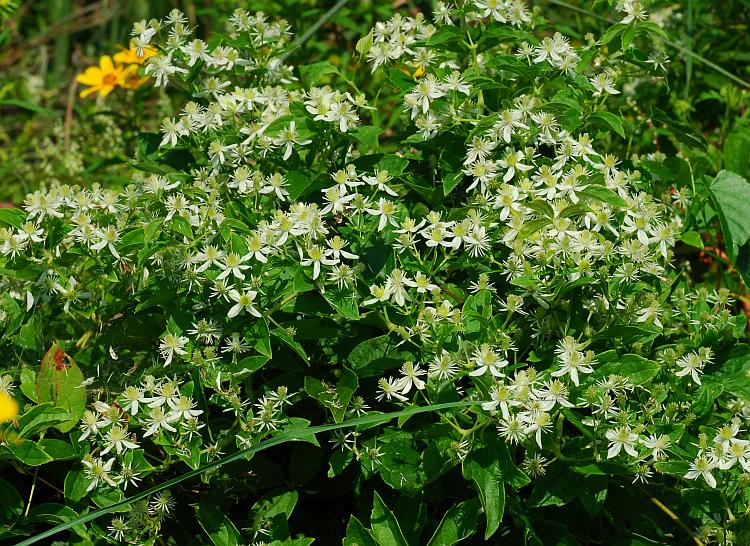Clematis virginiana L.
Virgin's Bower

Native
CC = 3
CW = 0
MOC = 35
© SRTurner
Clematis virginiana L.Virgin's Bower | |
 |
Native CC = 3 CW = 0 MOC = 35 |
© SRTurner |
|
Family - Ranunculaceae Habit - Twining perennial forb, dioecious, sometimes incompletely so. Stems - Twining and climbing, to 6 m, woody toward the base, sparsely to moderately pubescent.
Leaves - Opposite, mostly 3 foliate, petiolate. Leaflets lobed and/or coarsely toothed, typically ovate to lanceolate, herbaceous in texture, sparsely pubescent to glabrous, to 6 cm long, 3 cm broad, the undersurfaces paler but not glaucous. Petiolules to 1 cm long or sometimes absent on upper pair of lateral leaflets.
Inflorescence - Fairly dense axillary panicles. Each division of panicle subtended by pair of small leafy bracts. Peduncles and pedicels pubescent.
Flowers - Imperfect, fragrant, the perianth saucer-shaped. Petaloid sepals 4, 6-10 mm long, 4 mm broad, spreading, pubescent, entire, not thickened, white. Petals absent. Stamens around 25, erect to spreading. Filaments to 8 mm long, white, glabrous. Anthers pale yellow, 1.2 mm long. Pistillate flowers with sterile stamens. Pistils 6-10. Achenes silky-hairy, to 5 mm long. Styles plumose, to 3 cm long.
Fruits - Achenes with the beak 1.5-4.0 cm long, plumose with long spreading hairs. Flowering - July - September. Habitat - Moist and low ground of woodlands, moist slopes, streambanks, fence rows. Origin - Native to the U.S. Lookalikes - Clematis terniflora, Clematis catesbyana. Other info. - This showy and native species of Clematis is found in scattered locations throughout most of the state, and throughout most of the eastern continental U.S. It is not particularly common. When in flower it is quite conspicuous, with sprays of showy white flowers. It is easily confused with the two other white-flowered species of Clematis growing in the state. It can be differentiated from the introduced C. terniflora by its toothed leaves, and from the native C. catesbyana by having three, rather than five or more, leaflets on most leaves. Photographs taken at Young Conservation Area, Jefferson County, MO, 8-30-2016 (SRTurner). |